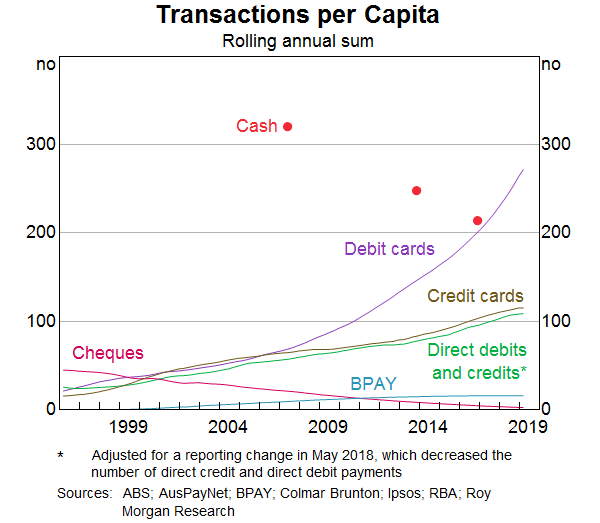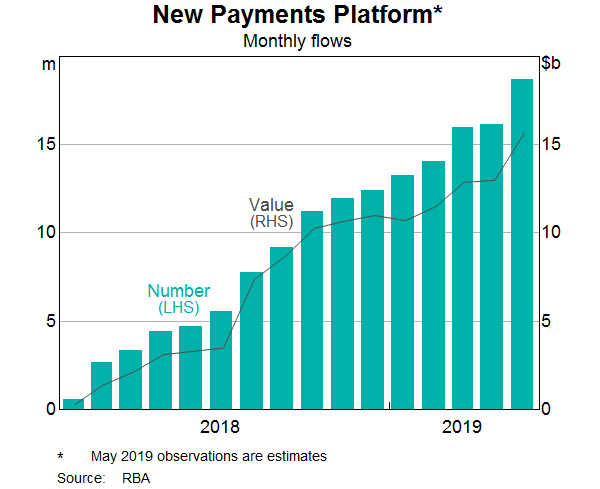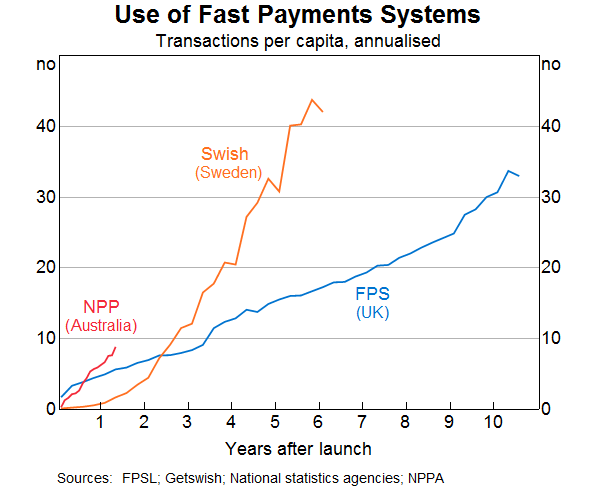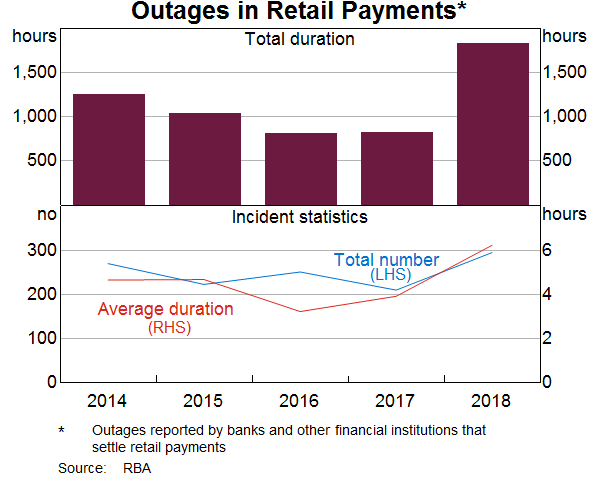Speech Modernising Australia's Payments System

Michele Bullock
Assistant Governor (Financial System)
Speech to the Central Bank Payments Conference
Berlin –
Today I am going to talk about Australia's continuing journey to modernise its payments infrastructure. An efficient, safe and reliable electronic payments system is an essential part of a well-functioning economy. Over the past decade, the way people shop and pay has been undergoing a transformation. Face-to-face and bill payments are increasingly being undertaken using electronic methods as people move away from cash and cheques. They are also increasingly shopping online at their convenience and they expect the payments system to provide them with efficient and secure ways of doing so. New ways of paying are springing up as innovative participants provide even more efficient and seamless payment experiences.
While much of this change has occurred through innovation by competing financial institutions, predominantly in customer-facing services, some parts of the core payments system infrastructure have required modernisation to handle this new environment. I am going to talk about three aspects of this modernisation from Australia's perspective – real-time payments infrastructure, message standards and resilience. First though, I will provide a bit of context on Australia's payments system.
A brief (modern) history of the Australian payments system
The Reserve Bank of Australia was given legislative responsibility for efficiency, competition and safety of the payments system in 1998. An inquiry into the financial system in 1997 identified the payments system as an area that could benefit from regulatory oversight.[1] So, in 1998, the government created the Payments System Board of the Reserve Bank. The Payments System Board has a mandate to promote efficiency and competition in the Australian payments system, as well as stability of the system. The Reserve Bank in turn oversees the system to determine how best to achieve these objectives and has powers to regulate to achieve those if necessary.
In 1998 when the Payments System Board was established, Australia had just introduced real-time gross settlement for high-value payments so a key element of systemic risk had been substantially addressed. On the retail payments side however, where efficiency and competition were more important, there had been very little focus. At the time, cash and cheques were king (Graph 1). Before the Bank's triennial consumer payments surveys, there was limited information available on the use of cash in transactions, although the evidence from withdrawals from Automated Teller Machines (ATMs) suggest that in the late 1990s, cash was the dominant payment mechanism in terms of the number of transactions.[2] Of the non-cash payment instruments, cheques were the single most important payment mechanism in the late 1990s, although their use was on the decline.

Over the past two decades, however, the payments landscape has undergone quite a remarkable transformation with electronic payment instruments displacing both cheques and cash. Australians currently make around 390 card transactions per person per year and a further 125 electronic payments directly between bank accounts. Cheques now account for less than 1 per cent of the number of non-cash payments, partly displaced by a move to paying bills electronically. And, while cash is still clearly an important payment instrument – particularly for low-value consumer transactions – the number of cash transactions per person has been declining over the past decade. We expect to see a further fall in the use of cash when we undertake our next consumer payments survey at the end of this year.
All of these changes have occurred against a backdrop of technological advances and innovation. Card payments, for example, moved from being paper-based to electronic with signature authorisation and then authorisation with personal identification number (PIN). And now most payments are ‘tap and go’, with cards being replaced by mobile phones and wearables in some cases. Direct payments between bank accounts have been given increasing life through the innovations of internet banking and mobile apps. Other digitally enabled ways of making payments (both domestic and cross-border) have sprung up to meet particular needs such as online and person-to-person. These changes reflect the response of payment service providers and payment systems to changing consumer preferences and the need to ensure that payment systems remain secure.
But as consumers and businesses increasingly rely on electronic payments, there is a need to ensure that the systems are modern, resilient, cost effective and safe. While some of this is being delivered through innovation and competition, in Australia we have been of the view that there is also a need to think strategically about the payments system. Some of this strategic thinking requires the various competitors in the payments system to work together. One example of this in Australia's case is the development of the New Payments Platform (NPP), our fast retail payments system.
The New Payments Platform
Fast retail payments are not new. A number of countries, including the United Kingdom, Sweden and Singapore have had such systems for some years.[3] In Australia, we had some success in speeding up settlement of electronic payments by introducing batch settlement of electronic payments numerous times during the day rather than one settlement the next morning. This had the effect of extinguishing interbank credit risk more quickly, potentially paving the way for banks to credit customers' accounts faster. But funds availability is different from settlement. And in Australia, it seemed that many banks lacked the ability to expedite the availability of funds to customers.
Aside from the lag in funds availability, other issues were increasingly apparent as consumers, businesses and government moved to electronic payments. There was very limited ability to send information with an electronic payment, payments couldn't be sent outside normal banking hours and payers needed to know the recipient's full account details to send payments. So, in 2012, after a review of innovation in the payments system, the Reserve Bank set out some high-level strategic objectives for the payments system and challenged the industry to determine how best to meet those objectives. Importantly, the Bank was looking for the industry to address the shortcomings identified in the electronic payments system so any solution would need to incorporate the ability to send and receive payments in real time outside normal business hours, with more remittance information and simpler addressing. The industry response was to develop and build what is known as the New Payments Platform (NPP) to meet these objectives.[4]
The NPP is essentially a clearing system for fast payments. It is a utility, owned and operated by a company, NPP Australia Limited (NPPA). NPPA's shareholders are the direct participants in the system – currently nine banks, three aggregators (that provide connectivity for smaller institutions) and the Reserve Bank (in its capacity as banker to the government). It is operated by SWIFT[5] under contract from NPPA. The NPP infrastructure comprises:
- a network over which payment clearing and settlement messages flow between the participants, and between the participants and the Fast Settlement Service (which I will come back to in a minute);
- payment gateways situated in each participant's ecosystem that facilitate switching of transactions through the network; and
- an addressing service, known as PayID, that allows customers to link their bank account to a simple identifier such as a phone number, email address or business identification number.
The NPP service is supported by the Fast Settlement Service (FSS), built and operated by the Reserve Bank to settle payments from the NPP one by one in real time 24/7.
When a payment is initiated through the NPP, the payer's bank first confirms with the recipient's bank that it can receive the payment and post the funds. Once it has this confirmation, the paying bank sends a settlement request to the FSS and, if there are sufficient funds in its account, the transaction is settled through the FSS and confirmation sent to both the paying and receiving bank. This all happens in a matter of seconds.
There is one other feature of Australia's fast payments service that is worth noting – the provision for value-added or ‘overlay’ services.[6] As noted above, the NPP is a utility that provides payment clearing services. But overlay services can use the NPP's core capabilities (fast payments with more detailed information and simple addressing) to provide commercial services. In effect, this allows for competition and innovation using the NPP. The first overlay service for example, Osko, is a retail-focused fast payment service that banks can offer their customers through their mobile and internet banking. It uses the NPP to clear and settle payments quickly with up to 280 characters of information transmitted with the payment and funds being posted to the recipient's account close to real time.
In some respects, Australia's fast payments system is at the cutting edge of fast payment systems. Australia is not the first to have such a system, but we have been able to learn from experience overseas and incorporate features such as ISO 20022 message formats, real-time settlement and a simplified addressing service. And the design of the system, which allows for competitive overlay services to use the infrastructure, gives the system flexibility to meet the future needs of users of the Australian payments system. Other overlay services in prospect are ‘payment with a document’ and ‘request to pay’, which would allow billers to request payment from a customer with the customer able to respond and pay in real time.
Since going live in February 2018, the system has been gradually increasing its volumes (Graph 2). In May, more than 18 million transactions were processed through the NPP amounting to over $15 billion. This is still small relative to the volumes that pass through other retail payment systems. But it is growing steadily and at least as quickly as some comparable overseas fast payment services when they were introduced (Graph 3). One of the positive aspects has been the broad participation of many small financial institutions. Customers of around 50 small banks, credit unions and building societies were able to make and receive fast payments from Day 1 and that number has since grown to around 70. We expect the volumes to continue to grow as banks increase the functionality they provide to customers.


Modernising message standards
Critical to the operation of electronic payment systems are message standards. Participants in payment systems need to have a standardised way of communicating with one another. Like many other countries, Australia has a mix of message standards for its various payment systems. Some systems such as the industry's High-value Clearing System and the system for clearing debt securities use SWIFT message types. Others such as the clearing systems for electronic payments and BPAY (a bill payment service) use proprietary message types. Many settlement messages also use proprietary standards. Card payments use message types based on standards mandated by the various schemes.
Over the past decade, many jurisdictions have started to move towards adopting international standards for messaging – specifically ISO 20022. I know this audience will be very familiar with this standard. It is an internationally recognised, general purpose standard for financial industry messaging; an open standard that is flexible, provides enhanced data structure and capacity and is network independent. Recognising the move towards international standards and the potential benefits, the NPP and FSS were both built using ISO 20022 messaging.
With SWIFT's global decision to migrate certain messaging formats to ISO 20022, the Reserve Bank believes it is appropriate to consider adoption of the ISO 20022 standard in Australian payment systems more broadly. In particular, given that those systems using SWIFT messaging will be required to transition, it seemed sensible to consider whether there were other Australian payment systems that might benefit from transitioning as part of the same project. The Reserve Bank, jointly with the Australian Payments Council, have commenced a process of consultation on migration to the ISO 20022 message standard in the Australian payments system.[7] Specifically, the consultation aims to assist the industry in coming to agreement on some key strategic decisions with respect to ISO 20022 migration. These include such things as the governance of the project, the timetable and the approach to implementation. But the issues I want to focus on here are the scope of the migration, possible enhancements to payment messaging and longer-run considerations about the design of the Australian payments system.
As noted above, there are a wide range of message types being used in Australian payment systems. Some will need to migrate because of SWIFT's plan to migrate away from its older message standards. For other systems such as card payment systems and BPAY, there would seem to be limited benefit to migrating away from their current message formats. But there are others where migration is not required that could be considered. For example, the Australian direct entry system that clears electronic credit and debit transactions could potentially migrate to using the ISO 20022 standard, improving the capacity of this system to carry information with the payment. And the migration might also provide an opportunity to introduce standards for messaging between financial institutions and their customers. The consultation aims to draw out whether participants think that the benefits of introducing international standards in these areas would outweigh any costs.
The migration also provides an opportunity to consider whether any enhancements to the current message content would be desirable. The consultation suggests a few examples including: payment purpose codes, identity information, Legal Entity Identifiers, remittance information and International Bank Account Numbers. Some of these enhancements could provide opportunities for efficiencies, such as facilitating straight-through processing, and help to streamline compliance activities relating to detecting and preventing financial crime.
Finally, the consultation aims to draw out views on the long-run design of the payments system. For example, as I described earlier, the NPP allows fast payments to be settled in real time, one by one using ISO 20022 message standards. Although it was built to mainly handle retail payments, the question is could it become the high-value payments system as well, avoiding the need to upgrade the existing high-value payments system? While I understand that some participants might find this attractive, in our view there would be a number of significant issues with such a move. Nevertheless, we are seeking views on this issue. Another example is the future of two legacy systems – the direct entry system and the cheque system. Thinking about the potential scope of migration to ISO 20022 provides an opportunity to think about whether in the long run, these systems should continue to be supported or whether the NPP with its modern infrastructure could effectively replace them.
Resilience of the payments system
The final point I want to discuss in the context of modernising the payments system is operational resilience. In Australia, resilience has received a lot of attention in the context of the high-value payments system and other infrastructure of systemic importance to the Australian financial system. But in the case of the retail payments system, the focus has traditionally been more on efficiency and competition. Yet outages that affect the ability of households and businesses to make and receive payments, or access account information, can cause significant inconvenience and disruption. And with the increasing use of electronic payment instruments and the reduction in people carrying and transacting in cash, the resilience of these systems is becoming critical to day-to-day economic activity. While modernising centralised infrastructure and payment systems is clearly very important for the future of payments, it is only as good as the systems of the participants themselves. Ageing and complex systems within financial institutions pose a significant risk to the efficiency and resilience of payment systems.
With this in mind, the Reserve Bank has, for some time, been collecting information on outages in retail payment services of Australian financial institutions. Specifically, since late 2013, the Bank has asked financial institutions that participate in the Reserve Bank's system for settling retail payments to report quarterly statistics on their retail payment incidents. These data cover incidents that – above certain thresholds – disrupt an operating site, retail clearing activity, and/or customer access to services and account information. To date, we have mainly used these data for monitoring.
Over the past year or so, however, there have been a number of high-profile incidents that have resulted in substantial customer disruption. For example, a number of banks have experienced lengthy outages in their internet banking services, and there have been occasions when card acquiring services have been unavailable at the point of sale. So recently the Bank and the Payments System Board have been looking more closely at these issues and asking whether more needs to be done to improve the resilience of these systems.
What do the data tell us? At a high level they show an improving trend from 2014 to 2017, but then a sudden reversal in 2018. That year, the total duration of retail incidents (i.e. total outage time) rose sharply (Graph 4). The rise in total duration was due to both a rise in the number of incidents and in the average duration of incidents. In other words, incidents were more frequent and services took longer to be restored. While I can't show information for individual institutions, I can say that the higher level of retail outages was pretty much across the board.

What else do we know about these outages? Around half of the number of service disruptions in 2018 were to mobile and online banking channels, while card services accounted for around 10 per cent of the incidents. The most common reported cause of outages was software failures. Both the number of software failures and the average time taken to resolve the issues rose sharply in 2018. More generally, the increasing complexity of the IT environment seems to be an important reason why incidents are taking longer to become resolved.
Ultimately, it is in the interests of financial institutions to ensure that their systems are resilient. But if some institutions are not keeping pace, they can have adverse effects, not only on their own customers, but also the customers of other financial institutions. Confidence in payment services might even be reduced. As noted above, these types of effects are becoming more important as the use of electronic payment methods grows. So there is, in our view, a case for the Reserve Bank to be looking at what it can do to encourage improved operational resilience. As a first step, we will be working with the industry and our prudential regulator, the Australian Prudential Regulation Authority, to produce a standard set of operational performance statistics for retail payments to be disclosed by individual institutions. We will also be engaging more with institutions to better understand the challenges of their IT systems and how they are managing operational risks to payment systems.
Conclusion
The Australian payments system has undergone a substantial transformation over the past few decades. Much of this has occurred as competition between payment systems and participants, and improvements in technology have driven innovation in payment offerings to consumers and merchants. Nevertheless, there are aspects of modernisation that have required a more centralised approach. Today, I have highlighted three aspects of the payments system in Australia that have required such an approach – fast payments, more modern and flexible messaging standards and improvements in resilience of retail payment systems. All these developments will enhance the efficiency and convenience for users of payment systems.
Endnotes
Financial System Inquiry (1997). [1]
Bullock M and L Ellis (1998), ‘Some Features of the Australian Payments System’, RBA Bulletin, December. [2]
See Committee on Payments and Market Infrastructures (2016), ‘Fast Payments – Enhancing the speed and availability of retail payments’, Bank for International Settlements, November. [3]
Rush A and R Louw (2018), ‘The New Payments Platform and Fast Settlement Service’, RBA Bulletin, September. [4]
The Society for Worldwide Interbank Financial Telecommunication. [5]
Note here that I am using the term ‘overlay’ in its NPP ‘value-added’ sense, and not in the way it is occasionally used to refer to ‘screen-scraping’. [6]
RBA and Australian Payments Council (2019), ‘ISO 20022 Migration for the Australian Payments System – Issues Paper’, April. The Australia Payments Council is the strategic coordination body for the Australian payments industry. [7]